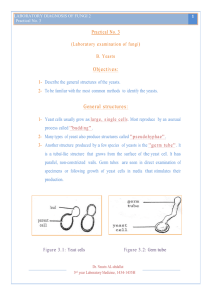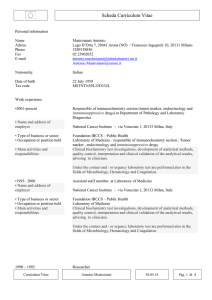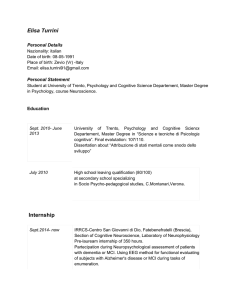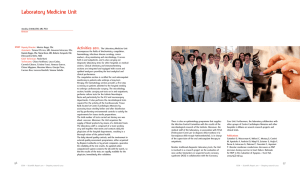PDF - Ral-sa
advertisement
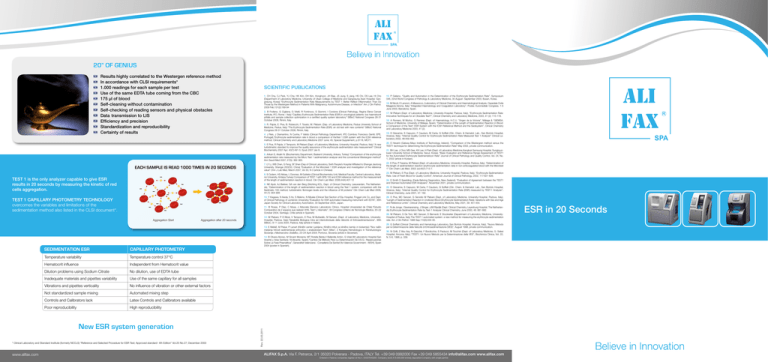
20” Of gENIuS Results highly correlated to the Westergen reference method In accordance with CLSI requirements* 1.000 readings for each sample per test Use of the same EDTA tube coming from the CBC 175 μl of blood Self-cleaning without contamination Self-checking of reading sensors and physical obstacles Data transmission to LIS Efficiency and precision Standardization and reproducibility Certainty of results SCIENTIFIC PUBLICATIONS 1. CH Cha, CJ Park, YJ Cha, HK Kim, DH Kim, Honghoon, JH Bae, JS Jung, S Jang, HS Chi, DS Lee, HI Cho (Department of Laboratory Medicine, University of Ulsan College of Medicine and Gangneung Asan Hospital, Gangneung, Korea) “Erythrocyte Sedimentation Rate Measurements by TEST 1 Better Reflect Inflammation Than Do Those by the Westergren Method in Patients With Malignancy, Autoimmune Disease, or Infection” Am J Clin Pathol. 2009 Feb;131(2):189-94 2. B Frollano, G Cigliana, G Vitelli, R Fontinovo, S Giommi, I Cordone (Clinical Pathology, Regina Elena Cancer Institute, IFO, Rome – Italy) “Capillary Erythrocyte Sedimentation Rate (ESR) in oncological patients: low haematocrit pitfalls and sample collection optimization in a certified quality system laboratory” SIBioC National Congress 28-31 October 2008, Rimini, Italy. 3. R. Pajola, E. Piva, B. Robecchi, F. Tosato, M. Plebani. (Dep. of Laboratory Medicine, Padua University School of Medicine, Padua, Italy) “The Erythrocyte Sedimentation Rate (ESR): an old test with new contents” SIBioC National Congress 28-31 October 2008, Rimini, Italy. 4. J Reis, J Diamantino, N Cunha, F Valido (Clinical Pathology Department, IPO Coimbra; Francisco Gentil, EPE, Portugal),“Erythrocyte sedimentation rate in blood a comparison of theTest 1 ESR system with the ICSH reference method. Clinical Chemistry and Laboratory Medicine 2007 June; 45, Special Supplement, p.S118, MO77. 5. E Piva, R Pajola, V Temporin, M Plebani (Dept. of Laboratory Medicine, University-Hospital, Padova, Italy) “A new turbidimetric standard to improve the quality assurance of the erythrocyte sedimentation rate measurement” Clinical Biochemistry 2007 Apr; 40(7):491-5. Epub 2007 Jan 8. 6. Arikan S, Akalin N. (Biochemistry Department, Baskent University, Ankara, Turkey) “Comparison of the erythrocyte sedimentation rate measured by the Micro Test 1 sedimentation analyzer and the conventional Westergren method” Ann Saudi Med 2007; 27(5): 362-365. 7. LY Li, WB Chen, G Feng, SF Shen (Dep of Clinical Laboratory, Sixth People’s Hospital Affiliated to Shangai Jiaotong University, Shangai 200233, China) “Evaluation of the Microtest 1 ESR analyzer and investigation of the reference value” Chin J Lab Med, March 2007, Vol 30, N 3 (article in Chinese) EACH SAMPLE IS READ 1000 TIMES IN 20 SECONDS 8. S Ozdem, HS Akbas, L Donmez, M Gultekin (Clinical Biochemistry Unit, Medical Faculty, Central Laboratory, Akdeniz University, Antalya,Turkey) Comparison of TEST 1 with SRS 100 and ICSH reference method for the measurement of the length of sedimentation reaction in blood. Clin Chem Lab Med. 2006;44(4):407-12 TEST 1 is the only analyzer capable to give ESR results in 20 seconds by measuring the kinetic of red cells aggregation. 9. NE Ajubi, AJ Bakker, GA van den Berg (Stichting KCL, Dept. of Clinical Chemistry, Leeuwarden, The Netherlands), “Determination of the length of sedimentation reaction in blood using the Test 1 system: comparison with the Sedimatic 100 method, turbidimetric fibrinogen levels and the influence of M proteins” Clin Chem Lab Med 2006, 44 (7): 904-906 TEST 1 CAPILLARY PHOTOMETRY TECHNOLOGY overcomes the variables and limitations of the sedimentation method also listed in the CLSI document*. Aggregation Start Temperature variability Temperature control 37°C Hematocrit influence Independent from Hematocrit value Dilution problems using Sodium Citrate No dilution, use of EDTA tube Inadequate materials and pipettes variability Use of the same capillary for all samples Vibrations and pipettes verticality No influence of vibration or other external factors Not standardized sample mixing Automated mixing step Controls and Calibrators lack Latex Controls and Calibrators available Poor reproducibility High reproducibility New ESR system generation * Clinical Laboratory and Standard Institute (formerly NCCLS) “Reference and Selected Procedure for ESR Test; Approved standard- 4th Edition” Vol.20 No.27; December 2000 www.alifax.com 18. A Romero, M Muñoz, G Ramirez (Dept. of Haematology, H.C.U. “Virgen de la Victoria”, Málaga & *GIEMSA, School of Medicine, University of Málaga, Spain), “Determination of the Length of Sedimentation Reaction in Blood: a Comparison of the Test1 ESR System with the ICSH Reference Method and the Sedisystem”, Clinical Chemistry and Laboratory Medicine 2003, 41 (2). 19. D Giavarina, S Capuzzo, F Cauduro, M Carta, G Soffiati (Clin. Chem. & Hematol. Lab., San Bortolo Hospital, Vicenza, Italy), “Internal Quality Control for Erythrocyte Sedimentation Rate Measured Test 1 Analyzer” Clinical Laboratory 2002, 48:459-462. 20. E Heverin (Galway-Mayo Institute of Technology, Ireland), “Comparison of the Westergren method versus the TEST1 technique for determining the Erythrocyte Sedimentation Rate” May 2002, private communication. 21. BH Lee, J Choi, MS Gee, KK Lee, H Park (Dept. of Laboratory Medicine,Kangbuk Samsung Hospital, Sungkyunkwan University School of Medicine, Seoul, Korea), “Basic Evaluation and Reference Range Assessment of TEST1 for the Automated Erythrocyte Sedimentatioon Rate” Journal of Clinical Pathology and Quality Control, Vol. 24, No. 1, 2002 (article in Korean). 22. E Piva, P Fassina, M Plebani (Dept. of Laboratory Medicine, University-Hospital, Padova, Italy), “Determination of the length of sedimentation reaction (erythrocyte sedimentation rate) in non-anticoagulated blood with the Microtest 1” Clin Chem Lab Med. 2002 Jul;40(7):713-7. 23. M Plebani, E Piva (Dept. of Laboratory Medicine, University-Hospital, Padova, Italy), “Erythrocyte Sedimentation Rate. Use of Fresh Blood for Quality Control”, American Journal of Clinical Pathology, 2002, 117:621-626. 24. D Smith D Spedding, (Dade Behring Diagnostics, New Zealand), “Evaluation of Agreement between the TEST1 and Starrsed Automated ESR Analysers”, November 2001, private communication. 25. D Giavarina, S Capuzzo, M Carta, F Cauduro, G Soffiati (Clin. Chem. & Hematol. Lab., San Bortolo Hospital, Vicenza, Italy), “Internal Quality Control for Erythrocyte Sedimentation Rate (ESR) measured by TEST-1 Analyzer”, Clinical Chemistry, June 2001, 47: 162. 11. B Rosas, P Díaz, C Musa, J Aldunate (Servicio Laboratorio Clínico, Hospital Universidad de Chile),“Estudio Comparativo de 2 equipos que realizan VHS, Test1 y Vesmatic”, XII Congreso Chileno de Tecnologia Medica, 20–22 October 2004, Santiago, Chile (article in Spanish). 27. N de Jonge, I Sewkaransing, J Slinger, JJM Rijsdijk (Dept. Clinical Chemistry, Leyenburg Hospital, The Netherlands) Erythrocyte Sedimentation Rate by Test-1 Analyzer Clinical Chemistry, June 2000, 46: 881-882. 14. B Olivera Alonso, M Sirvent Monerris, MT Rotella Belda,V Ballenilla Antón, G Vidal (M Laboratorio Hospital San Vicente y Area Sanitaria 18.Alicante, Spain),“Cambio De Método Para La Determinación De V.S.G.: Repercusiones Sobre La Fase Preanalítica”, Generalitat Valenciana - Conselleria De Sanitat (for Valencia Government – MOH), Spain 2004 (poster in Spanish). 28. M Plebani, S De Toni, MC Sanzari, D Bernardi, E Stockreiter (Department of Laboratory Medicine, UniversityHospital of Padua, Italy) The TEST 1 automated system: a new method for measuring the erythrocyte sedimentation rate. Am J Clin Pathol. 1998 Sep;110(3):334-40. 29. G Soffiati (Clinical Chemistry and Hematology Laboratory, San Bortolo Hospital, Vicenza, Italy), “Nuovo Metodo per la Determinazione della Velocità di Eritrosedimentazione (VES)”, August 1998, private communication. 30. N Cirilli, Z Abu Asy, N Giacchè, F Bordicchia, S Paolucci, M Tocchini (Dept. of Laboratory Medicine, G. Salesi Hospital, Ancona, Italy), “TEST1: Un Nuovo Metodo per la Determinazione della VES”, Biochimica Clinica, Vol. 22, N. 5-6, 1998, p. 339. Rev. 22.03.2011 CAPILLARY PHOTOMETRY 17. M Plebani (Dept. of Laboratory Medicine, University-Hospital, Padova, Italy), “Erythrocyte Sedimentation Rate: Innovative Techniques for an Obsolete Test?”, Clinical Chemistry and Laboratory Medicine, 2003, 41 (2): 115-116. 26. E Piva, MC Sanzari, G Servidio M Plebani (Dept. of Laboratory Medicine, University-Hospital, Padova, Italy), “Length of Sedimentation Reaction in Undiluted Blood (Erythrocyte Sedimentation Rate): Variations with Sex and Age and Reference Limits”, Clinical Chemistry and Laboratory Medicine, May 2001, 39: 451-454. 13. E Melkič, M Piskar, P Lenart (Klinični center Ljubljana, Klinični intitut za klinično kemijo in biokemijo) “Nov način merjenja hitrosti sedimentacije eritrocitov z analizatorjem Test1 Alifax”, 2 Kongres Hematologov in Transfuziologov Slovenije z Mednarodno UbeleÏbo, 23–24 April 2004, Portoroz, Slovenia (article in Slovenian). SEDIMENTATION ESR 16. M Nicoli, E Lanzoni, A Massocco, (Laboratory of Clinical Chemistry and Haematological Analysis, Ospedale Civile Maggiore,Verona, Italy) “Integrated Haematology and Coagulation Laboratory”, Poster, Euromedlab Congress, 1-5 June 2003, Barcelona, Spain. 10. Y Kagawa, N Ikeda, S Ito, S Makino, N Miyake (Clinical Test Section of Eiju Hospital, Finggal Link Co. and Dept. of Clinical Pathology of Juntendo University),“Evaluation for ESR automated measuring instrument with EDTA”, 36th Japan Society for Clinical Laboratory Automation, 30 September 2004, Japan. 12. M Plebani, P D’Altoé, V Temporin, E Piva, M Buttarello, M Sanzari, (Dept. of Laboratory Medicine, UniversityHospital, Padova, Italy),“Variabilità Biologica Intra ed Interindividuale della Velocità di Eritrosedimentazione”, 36th SIBioC, 8-11 June 2004, Padova, Italy (article in Italian). Aggregation after 20 seconds 15. P Galiano, “Quality and Automation in the Determination of the Erythrocyte Sedimentation Rate”, Symposium 046, 22nd World Congress of Pathology & Laboratory Medicine, 30 August- September 2003, Busan, Korea. ALIFAX S.p.A. Via F. Petrarca, 2/1 35020 Polverara - Padova, ITALY Tel. +39 049 0992000 Fax +39 049 5855434 info@alifax.com www.alifax.com Entered in Padova companies register at the n. 04337640280. Company stock € 6.000.000 entirely deposited Company with single partner ESR in 20 Seconds MARKED Latex Control Kit 6 tests External Quality Evaluation Kit Specific for Test 1 family instruments Code SI 305.500-A (Greiner tubes), SI 305.502-A (Sarstedt tubes) Code SI 195.260/XDL Up to 60 samples per session with ALIFAX green plastic racks. Up to 48 samples per session with Beckman Coulter CBC racks. Up to 40 samples per session with ALIFAX yellow plastic racks. Up to 40 samples per session with Sysmex CBC racks. Up to 40 samples per session with ALIFAX blue plastic racks. Up to 40 samples per session with Siemens CBC racks. Up to 40 samples per session with Beckman Coulter CBC racks. Up to 40 samples per session with Beckman Coulter CBC racks. Test 1 - THL-BLC-SDL-YDL-MDL-XDL Technical Features Power supply: 115-260 VAC 10%, 50/60 Hz www.alifax.com Power consumption: 150 VA max. SHELF LIFE: From production: 6 months. From the I° piercing: 6 weeks Roller 20LC NEw TwO PARAMETERS CARDS fOR TEST 1 fAMILY INSTRuMENTS Smart CARDS Results in 20 seconds related to red cells aggregation First result available after 5 minutes from analysis start No reagents required Results expressed in mm/h High correlation with the Westergren method No influence of low hematocrit levels Use of the same CBC tubes Only 800 μl sample requested in the tube Latex Calibration & Controls Smart cards Thermostated at 37°C Mixing cycles in accordance with CLSI requirements* Connection to LIS Simplified needle replacement Thermal printer Automated washing Size: 510x560x600 mm Weight: 45 Kg In/ out specifications: two RS232 serial ports Bar code reader: internal Power supply: 115-230 VAC, 50/60 Hz Power consumption: 50 VA max Operative temperature: from +10 to +30 °C Size: 320x560x580 mm tor 1000 tests 4000 tests 10000 tests 20000 tests Code SI R20-LC Roller 20LC Technical Features Operative temperature: from +10 to +30 °C STORAGE CONDITIONS: refrigerated temperature (+2÷8°C) ac Test 1 xDL Code SI 195.250/MDL Optional accessories: external CCD bar code reader em Test 1 MDL Code SI 195.240/YDL In/ out specifications: two RS232 serial ports An Test 1 YDL Code SI 195.230/SDL Weight: 14/16 Kg R+ Test 1 SDL Code SI 195.220/BCL Size: 240x380x450 mm ES Test 1 bCL Operative temperature: from +10 to +30°C MARKED NEw DIRECT LOADINg fROM THE ORIgINAL CELL bLOOD COuNTER RACk Power consumption: 100VA Code SI 305.300-A (Greiner tubes), SI 305.302-A (Sarstedt tubes) Alifax ESR External Quality Programs successfully started in many Countries! Roller 10PN/20PN Technical Features Power supply: 115-230 VAC, 50/60 Hz Latex Control Kit 30 tests Code SI 305.100-A (Greiner tubes), SI 305.102-A (Sarstedt tubes) and automatic washing system 10 samples gy • Pa LOW ia F MARKED HIG H nolo Up to 60 samples per session with standard Test1 racks. Cell Blood Counter racks adapters available. Precision Accuracy Repeatability MARKED • Pa gy h Code SI 195.210/THL nolo Test 1 THL THREE LEvELS TO guARANTEE: 3 levels 1 certainty Results in 20 seconds related to red cells aggregation First result available after 5 minutes from analysis start No reagents required Results expressed in mm/h High correlation with the Westergren method No influence of low hematocrit levels Use of the same CBC tubes 100 μl EDTA blood sample with manual withdrawal and 175 μl with automated withdrawal per test Only 100 μl sample requested in the tube for manual withdrawal and 800 μl for automated withdrawalOnly 800 μl sample requested in the tube Latex Calibration & Controls Smart cards Thermostated at 37°C Mixing cycles in accordance with CLSI requirements* LCD touch screen User-friendly software Code SI R10PN, SI R20PN Connection to LIS Roller 20 PN Roller 10 PN Simplified needle replacement 2 rotors for 20 samples 1 rotor for Thermal printer h Results in 20 seconds related to red cells aggregation First result available after 5 minutes from analysis start No reagents required Results expressed in mm/h High correlation with the Westergren method No influence of low hematocrit levels Use of the same CBC tubes 175 μl EDTA blood sample per test Only 800 μl sample requested in the tube Capacity up to 60 samples Throughput up to 180 samples/hour Latex Calibration & Controls Smart cards Thermostated at 37°C Mixing cycles in accordance with CLSI requirements* Internal bar code reader Connection to LIS Simplified needle replacement Thermal printer Complete integration in the hematology laboratory LATEx CONTROLS Roller 20PN nte Te c Roller 10PN Test 1 te d fuLLY AuTOMATED ANALYzER fOR THE DETERMINATION Of THE ESR wITH ExTERNAL NEEDLE fOR PEDIATRIC SAMPLES AND uNCAPPED TubES M DIU ME Te c Test 1 nte d fuLLY AuTOMATED ANALYzER fOR THE DETERMINATION Of THE ERYTHROCYTE SEDIMENTATION RATE te Weight: 23,2 kg ca In/out specifications: two RS232 serial ports Optional accessories: external CCD bar code reader Environmentally friendly cards save storage and transport costs. Only pay for a test when needed. www.alifax.com
